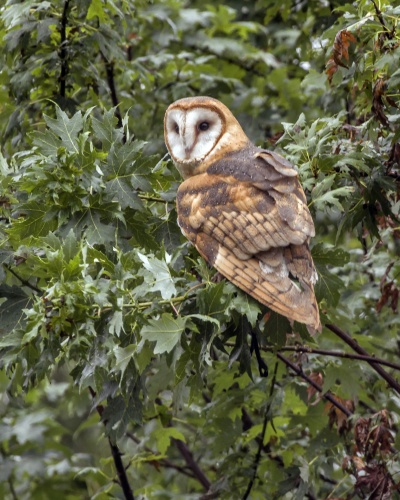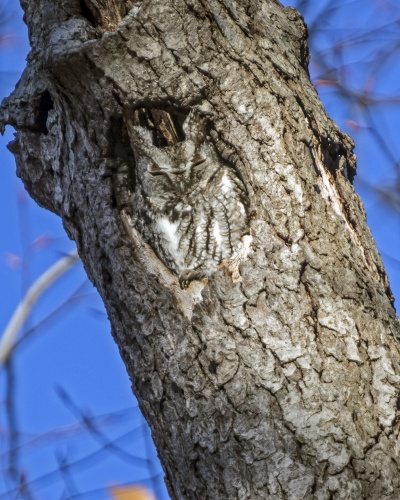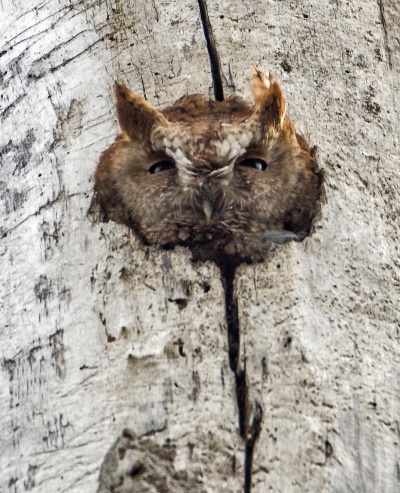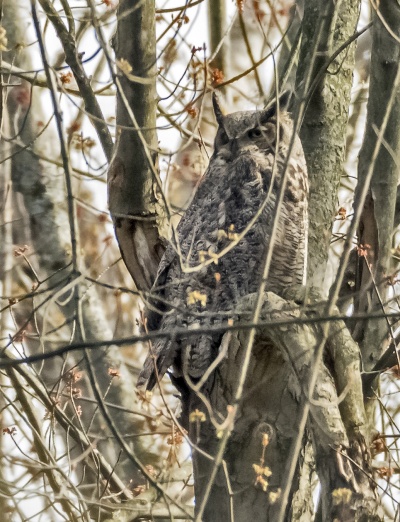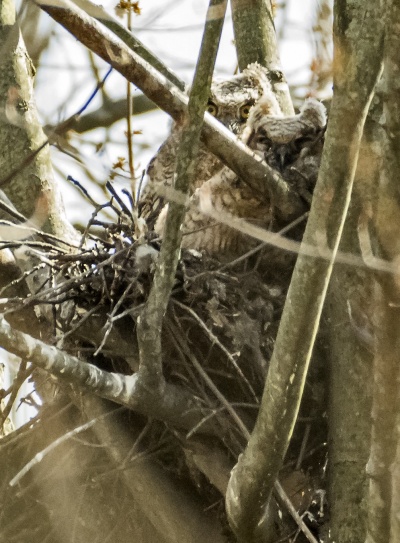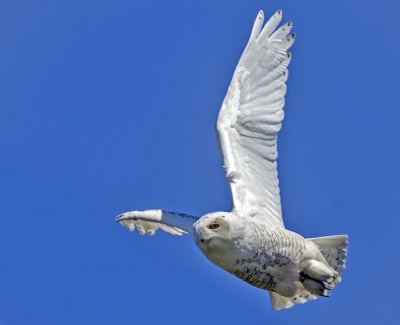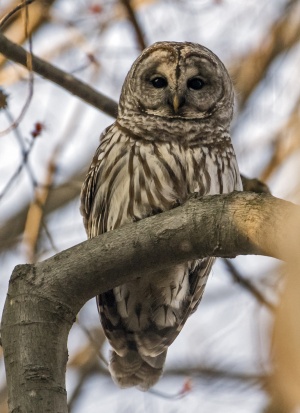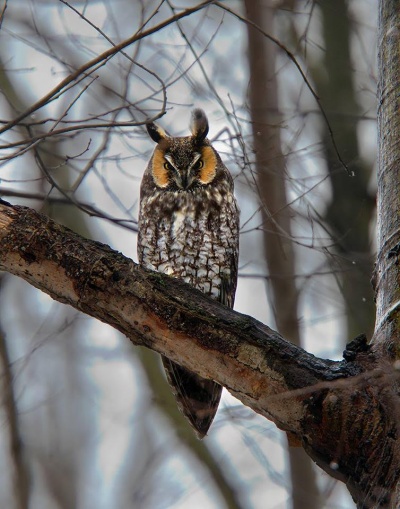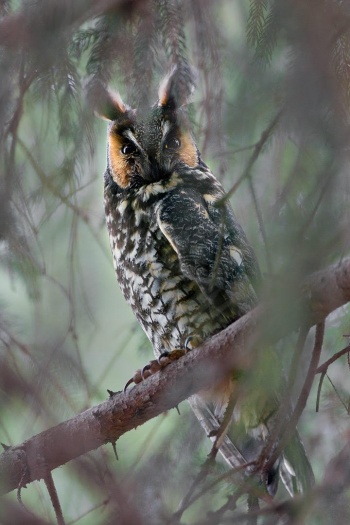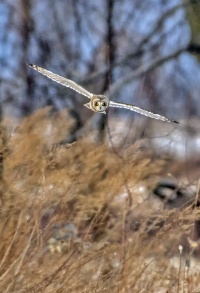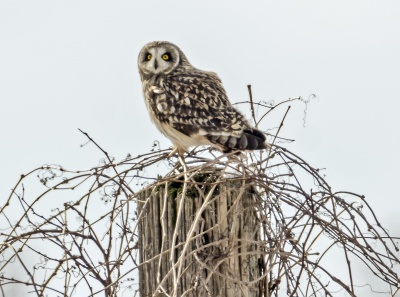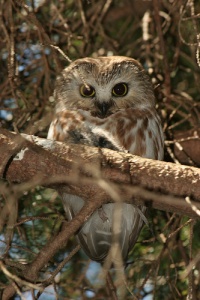Owls
|
|
Owls, like Eagles, Falcons, Osprey, and Hawks, are birds of prey.
Contents
Barn Owls
Barn Owl
(Tyto alba)
RARE: Pale owl; white below and orangey with gray spotting above. Heart-shaped white facial disc. Hunts primarily rodents in open areas by night. Roosts in old buildings and nest boxes by day. Widespread across every continent except Antarctica. Appears very white in headlights at night. Its call is a bone chilling, rising shriek. Barn Owls have not been recorded by local birders in recent years, nor have they been recently photographed in the wild locally at all. Rumors persist of Barn Owls on private property, however none have been confirmed by the birding community. The image included is a captive Barn Owl used by Hawk Creek Wildlife Center for educational purposes
Typical Owls
Eastern Screech Owl
(Otus asio)
COMMON: Year round resident, found in many woodlots. Small, stocky owl with large head and no neck. Pointed ear tufts are often raised. Varies in color from gray to bright rufous (reddish-brown). Intricate pattern is perfect for camouflage against tree bark. Yellow eyes. Active at night when they prey on small birds and mammals. More often heard than seen; listen for its descending whinny and longer trill. Roosts and nests in tree cavities, and in some cases, nest boxes. Found in a variety of habitats with trees, particularly near water. Eastern Screech Owls are quite common throughout Western New York. They are year round residents and can best be found in late fall, winter and early spring before the spring/summer foliage becomes established.
Great Horned Owl
(Bubo virginianus)
COMMON: Year round resident. Large and widespread owl with distinctive ear tufts. Found in a variety of habitats from dense woods to prairie and deserts with at least some trees. Also, found in wooded towns and suburbs. Typically well-camouflaged dark brown overall, but varies in color. Often engages in haunting duets, with males and females hooting back and forth. Preys upon a variety of animals, including mammals, birds and reptiles. The Great Horned Owl is a quite common year round resident that lives and breeds in all of Western New York. This owl is found in any area that can provide suitable roosting and breeding trees with enough prey to sustain them in urban, suburban and rural habitats. In urban locations, they spend a lot of time hunting rodents and rats, however, doing so makes them susceptible to poisons those rodents may have ingested.
Snowy Owl
(Nyctea scandiaca)
RARE to UNCOMMON: Only seen during the winter months then migrate north for the warm weather months. The Snowy Owl is a migratory owl that can be found in Western New York during the winter months from late November through March.
They can be found along the Buffalo Waterfront, large, somewhat flat fields and even small airports in WNY.
Beautiful owl. Completely white with variable amount of brown to black markings. In general, old males are the whitest, while immature females have the most dark markings. Favors lakeshores and coastal areas with fields, marshes, piers, and sand dunes in winter. Breeds on arctic tundra and irrupts south in numbers only some winters.
Barred Owl
(Strix varia)
COMMON: Year round resident. Large owl, mottled brown and white. Rounded head lacks ear tufts. Black eyes. Listen for its instantly recognizable “Who cooks for you? Who cooks for you all” call. Favors large, mature forests with deciduous and coniferous trees, often near water. Hunts small animals at night; however, is more active during the day than other owls. The Barred Owl is quite common and a year long resident, that lives and breeds in Western New York. Most easily seen during Fall, winter and early spring before the foliage becomes thick and established for the summer.
Long-Eared Owl
(Asio otus)
RARE to UNCOMMON: Only seen during migration. Medium-sized, rather slender owl with orange face patches and long "ear" tufts. Strictly nocturnal. Found in areas with a mix of dense cover for roosting, such as brushy thickets or conifer groves, and open spaces for hunting. Generally rare and seldom-seen, but can gather in communal winter roosts with dozens of individuals (if you're lucky enough to find a roost, do not disturb the birds). Size and shape similar to Short-eared Owl; but Long-eared is darker and more coarsely marked below with orange patch near the wingtips. Typical vocalization is a single low hoot repeated every few seconds; also gives a wide range of maniacal catlike screeches and doglike barks.
Short-Eared Owl
(Asio flammeus)
UNCOMMON: Only seen in the winter then migrates back north for the warmer months. Medium-sized owl, more frequently seen in the daytime than other owls. Especially active around dawn and dusk, when it flies lazily over open fields or marshes in search of small mammals. Overall rather pale brown, palest on belly, with streaks and spots on wings and chest. Large buffy patch near the wingtips easily visible in flight. Females darker brown than males. Rarely heard vocalizing away from breeding grounds, where it makes a low series of hoots and a variety of harsh barking noises. Short Eared Owls are migratory and breed in Northern Canada. They are found in Western New York mainly in the winter. Their winter hunting habitat is usually large rural tracts of uncut fields. Many times they will share a a specific tract of open fields with Northern Harriers and many times fight over a successful catch. Over the past couple of years have been found locally to the Buffalo area outskirts and even in open brownfields of the waterfront.
Northern Saw-Whet Owl
(Aegolius acadicus)
UNCOMMON: Only seen during migration. Pint-sized owl of the U.S., Canada, and Mexico; found in northern forests and western mountains. Prefers areas with conifers and thick understory. Fairly common, but shy and difficult to see. Patterned with brown and white overall, with streaked white forehead and blotchy rusty-brown streaks below. No ear tufts. Migratory, but numbers of migrants fluctuate greatly from year to year. Named for its loud, repetitive whistles that sound like a saw being whetted (sharpened). Also gives a harsher, rising screech. Most similar to less common Boreal Owl. Saw-whet is smaller with streaks (not spots) on forehead and richer orange-brown streaks on underparts. The Saw-Whet Owl is a migratory owl and is most likely to be found during the early spring (Late February thru early May) when they are heading to their summer habitat in Canada and again in the fall as they head south for the winter. Local sightings have been sporadic and somewhat random. However Owl Woods near Braddock Bay in the Rochester area records numerous sightings each spring.
